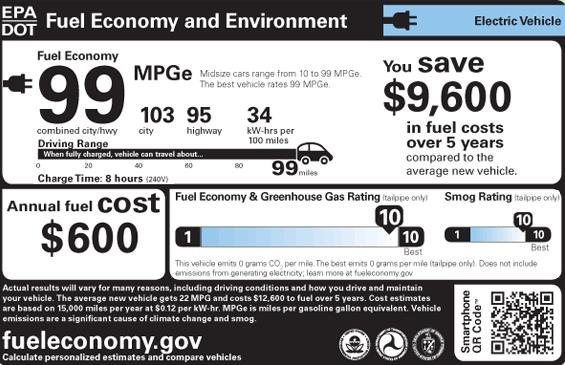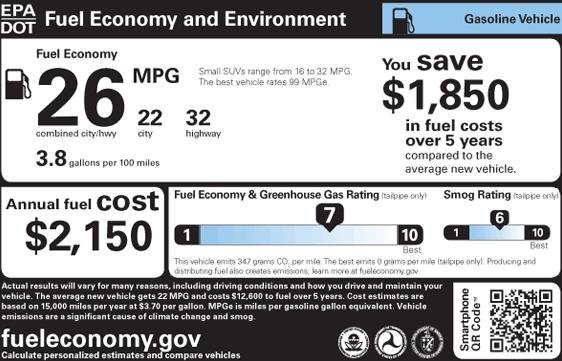 New EPA Fuel Economy label to offer fuel cost comparisons
New EPA Fuel Economy label to offer fuel cost comparisons
With the introduction of 2013 model year vehicles, the Environmental Protection Agency (EPA) Fuel Economy Label will be updated as shown in the photograph above. Of course, this is the label for electric vehicles (EVs). The label for gasoline powered vehicles will look like this:
 And finally, the EPA Fuel Economy Label for plug-in hybrid vehicles will look like this:
And finally, the EPA Fuel Economy Label for plug-in hybrid vehicles will look like this:
The bottom of each sticker provides the standard disclaimer – “Actual results will vary…” But let’s take a closer look at the number in the upper right corner of each sticker. “You save $x,xxx in fuel costs over 5 years compared to the average new vehicle.”
Explaining the gasoline EPA Fuel Economy Sticker
The fine print on the bottom of each sticker declares that the average new vehicle gets 22 miles per gallon (mpg). It also provides an estimate of the cost of fuel for that model year (in the example above $3.70 per gallon). All vehicles are estimated to be driven 15,000 miles each year.
First of all, don’t try to run the numbers using the above examples. Clearly there is rounding involved to get the numbers indicated in all cases, but they are close enough to be representative. In the example above, since that gasoline vehicle gets 26 miles per gallon you save $1,850 over a five year time frame compared to the average new car. A careful reading will also show that this sticker belongs on a small SUV.
Explaining the Electric Vehicle EPA Fuel Economy Sticker
Since the electric vehicle uses electricity instead of gasoline a different means of comparison is called for. The EPA has calculated that, in this example, 34 kilowatt hours (kWh) will get you 100 miles down the road. That number will vary from vehicle to vehicle, just as mpg varies in gasoline powered cars. Also, the average estimated cost of electricity is projected to be $0.12 per kWh. Again, it is simply a case of doing the math. The electricity cost to drive this vehicle 15,000 miles is $600 based on the above assumptions. Compared to the average new vehicle, this provides a five year cost savings of $9,600.
The Plug-in Hybrid provides a significant cost savings as well when compared to the average new vehicle.
Electric vehicles and plug-in hybrids will be sitting side-by-side on dealership lots and shoppers will be looking at and comparing these stickers. We feel that as a result, more individuals will understand that an electric vehicle or plug-in hybrid may actually fit into their driving situation. Saving money can be a hugely motivating factor. Also, in 2013 we will see more electric vehicles and plug-in hybrids offered by more manufacturers in more vehicle configurations. Just as in the gasoline powered automobile world, expanding vehicle choice will bring more shoppers into the segment.
One other not insignificant point to keep in mind is this – the above labels and their results project a fixed price for both gasoline and electricity. As we know, both cost more over time. We recently wrote that gasoline has more than tripled in cost over the past 10 years, while the cost of electricity has gone up about 45% during that same time frame. Taking future gas price hikes into consideration will make EVs even more appealing to more shoppers as they are introduced to these cost saving ideas via this new EPA Fuel Economy Label.


Wow, that is awesome Ernie – the EPA Labels look great and really get the message across. Nice. Great piece.
Short of another economic downturn (dropping the price of oil – not outside the realm of possibility with Europe having its issues), the price of oil should stay high and go higher by next year. I don’t think $4 will have the same impact as it did back in 2008 (the frog in the warm water has gotten used to $3+ gasoline) but when we pass $4.5 to $5 a gallon it’ll have impact and these Labels are perfect.
Of course the national election this fall can drastically affect this – if the GOP sweeps (not likely but not outside the realm of possibility) I’d bet money they’ll kill the temporary tax credit for plug-ins very early into 2013 and sales would go through the floor. This political possibility is unlikely, and as you said 2013 should be a great year for plug in cars (EV’s in particular) – I can’t wait to see some serious numbers coming out of Smyrna (and hopefully a 6+ kW charger).
Pingback: California gas prices top the nation — Living LEAF